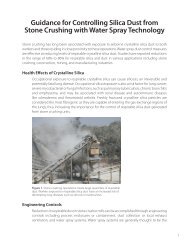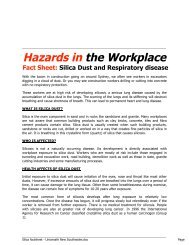Safety & Health in the Stone Crushing Industry - Occupational ...
Safety & Health in the Stone Crushing Industry - Occupational ...
Safety & Health in the Stone Crushing Industry - Occupational ...
Create successful ePaper yourself
Turn your PDF publications into a flip-book with our unique Google optimized e-Paper software.
26<br />
We will discuss <strong>the</strong>se solutions <strong>in</strong> <strong>the</strong> next chapters. You will f<strong>in</strong>d <strong>in</strong>formation on dust reduction<br />
systems that use<br />
(a) water sprayers or<br />
(b) a ventilation system<br />
A.3.1 Reduc<strong>in</strong>g Dust When Water is Available<br />
Perry Gottesfeld, <strong>Occupational</strong> Knowledge International, San Francisco USA<br />
Water spray dust control measures are effective at reduc<strong>in</strong>g respirable crystall<strong>in</strong>e silica dust. Studies<br />
have reported significant reductions with <strong>the</strong> use of wet methods to control silica dust <strong>in</strong> various<br />
applications <strong>in</strong>clud<strong>in</strong>g stone crush<strong>in</strong>g, construction, m<strong>in</strong><strong>in</strong>g, and manufactur<strong>in</strong>g <strong>in</strong>dustries.<br />
Reductions <strong>in</strong> respirable dust <strong>in</strong> stone crusher mills can be accomplished through eng<strong>in</strong>eer<strong>in</strong>g controls<br />
<strong>in</strong>clud<strong>in</strong>g process enclosures (or conta<strong>in</strong>ment), dust collection (or local exhaust ventilation), and water<br />
spray systems. Water spray suppression systems may be pressurized or rely on available water<br />
pressure. Basic systems without pressurization can be effective at significantly reduc<strong>in</strong>g respirable<br />
silica if an adequate number of well positioned spray nozzles are used.<br />
Silica content is known to vary greatly from area to area and may help to determ<strong>in</strong>e <strong>the</strong> necessary<br />
extent of controls. Quarry and mill owners can test samples of <strong>the</strong> rock to determ<strong>in</strong>e <strong>the</strong> silica content.<br />
Water Spray System Design<br />
The spray nozzle is selected to achieve <strong>the</strong> desired spray characteristics, velocity, spray pattern and<br />
angle. Below is a general discussion of <strong>the</strong>se factors:<br />
Droplet and Orifice Size: Droplet size is <strong>the</strong> most important variable for proper dust control and is<br />
determ<strong>in</strong>ed by <strong>the</strong> orifice size and available pressure. The smallest droplets are generated with<br />
pressurized systems.<br />
Droplet Velocity: Normally, higher droplet velocities are desirable for dust suppression control.<br />
Information on <strong>the</strong> droplet velocity, based on <strong>the</strong> available water pressure, can be obta<strong>in</strong>ed from <strong>the</strong><br />
nozzle manufacturer.<br />
Spray Pattern: Nozzles are categorized by <strong>the</strong> spray patterns <strong>the</strong>y produce. The follow<strong>in</strong>g describes<br />
<strong>the</strong> different spay nozzles used <strong>in</strong> dust control:<br />
−<br />
−<br />
−<br />
−<br />
Full-cone nozzles produce a round spray pattern and provide high velocity over a distance. These<br />
nozzles provide optimal surface area coverage for non-pressurized spray systems<br />
Hollow-cone nozzles produce a spray pattern <strong>in</strong> <strong>the</strong> form of circular r<strong>in</strong>g. Droplet range is<br />
normally smaller than <strong>the</strong> o<strong>the</strong>r types of nozzles<br />
Flat-spray nozzles produce a rectangular or even spray pattern. They also produce relatively<br />
large droplets that are delivered at high pressure<br />
Air Atomiz<strong>in</strong>g nozzles require a pressurized system to produce very f<strong>in</strong>e mist. They are very<br />
effective <strong>in</strong> locations where airborne dust particles are extremely small and nozzles can be located<br />
<strong>in</strong> close proximity to <strong>the</strong> dust source<br />
Spray Angle: The spray angle determ<strong>in</strong>es <strong>the</strong> width of <strong>the</strong> cone-shaped spray pattern produced by <strong>the</strong><br />
nozzle. The appropriate spray angle needed to cover a specific surface area would depend on <strong>the</strong><br />
distance <strong>the</strong> nozzle is placed from <strong>the</strong> material.







